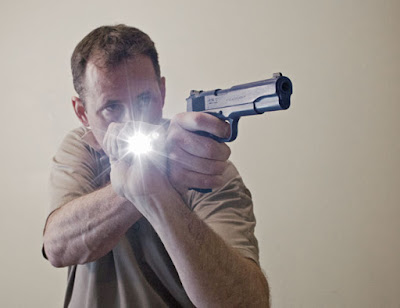 Periodically Texas License to Carry instructors must fire the LTC qualification to renew their instructor certificate. In Texas, an LTC instructor must qualify with a .32 caliber or larger revolver and a semi-automatic pistol. I fired the qualification in July of 2019.
Periodically Texas License to Carry instructors must fire the LTC qualification to renew their instructor certificate. In Texas, an LTC instructor must qualify with a .32 caliber or larger revolver and a semi-automatic pistol. I fired the qualification in July of 2019.For the revolver I chose to qualify with a 4-inch S&W 44 Remington Magnum with a heavy (however not absolutely full power) 240 grain load that is about the equivalent of the Remington factory Semi-Jacketed HP load. For the semi-auto I shot my everyday carry SIG P320 carry in 9mm with the equivalent of the Hornady 135gr Critical Duty load.
My goal for the semi was 50 shots in the "X" ring. To shoot well you must do the same thing, the correct way, every time. My students tell me that my mantra is often the one thing that really sticks in their mind. I tend to repeat it over and over during the course of a class. I did not do this with the semi and slipped two in the Ten ring due to two sloppy trigger pulls. The same thing, the correct way, 48 out of 50 times--I missed my goal.
Chased the same goal with the revolver and dropped a few more outside the "X" ring and two in the Nine ring. Grrrrrr. . .

The Texas License to Carry qualification is as follows: Your handgun must be .32 caliber or larger.
Course of Fire:
3 yard line – 20 shots:
- 1 shot in 2 seconds, 5 times
- 2 shots in 3 seconds, 5 times
- 5 shots in 10 seconds, once
7 yard line – 20 shots:
- 5 shots in 10 seconds, once - 1 shot in 3 seconds, 5 times - 2 shots in 4 seconds, once - 3 shots in 6 seconds, once - 5 shots in 15 seconds, once
15 yard line – 10 shots:
- 2 shots in 6 seconds, once - 3 shots in 9 seconds, once - 5 shots in 15 seconds, once
An LTC student must score of 70% or 175 points of a possible 250 to pass. An LTC instructor must score at least 90% or 225 points to pass. Five points for each shot within the 8 ring, 4 points for each shot within the 7 ring, 3 points for each shot within the colored silhouette, but outside the 7 ring, no points for shots outside the silhouette.
I fired a possible score of 250 on both qualifications; however, that was not the point. I missed my goal.
If you enjoy reading these please subscribe. The link is on the upper right side of the page. All that will happen is that you will receive an e-mail when I post an article. Your information will never be distributed.


